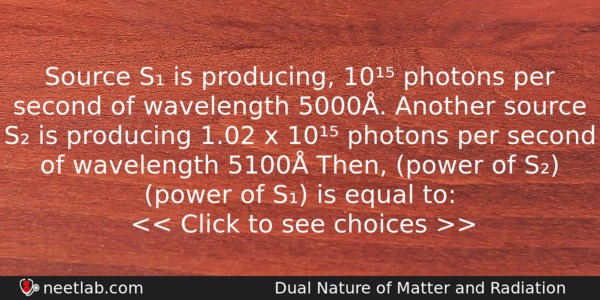| ⇦ | 
| ⇨ |
Source S₁ is producing, 10¹⁵ photons per second of wavelength 5000Å. Another source S₂ is producing 1.02 x 10¹⁵ photons per second of wavelength 5100Å Then, (power of S₂) (power of S₁) is equal to:
Options
(a) 1
(b) 1.02
(c) 1.04
(d) 0.98
Correct Answer:
1
Explanation:
energy emitted/sec by S₁, P₁ = n₁ hc / λ₁
energy emitted/sec by S₂, P₂ = n₂ hc / λ₂
P₂ / P₁ = n₂ / n₁ . λ₁ / λ₂
= 1.02 x 10¹⁵ / 10¹⁵ . 5000 / 5100 = 1.0
Related Questions: - 180⁰ phase difference is obtained when light ray is reflected from
- A thin semicircular conducting ring (PQR) of radius r is falling with its plane
- The ratio of longest wavelength corresponding to Lyman and Blamer series
- A coil of resistance and 1.0 H inductance is connected to an a.c. source of frequency
- A stone thrown into still water, creates a circular wave pattern moving radially
Topics: Dual Nature of Matter and Radiation
(150)
Subject: Physics
(2479)
Important MCQs Based on Medical Entrance Examinations To Improve Your NEET Score
- 180⁰ phase difference is obtained when light ray is reflected from
- A thin semicircular conducting ring (PQR) of radius r is falling with its plane
- The ratio of longest wavelength corresponding to Lyman and Blamer series
- A coil of resistance and 1.0 H inductance is connected to an a.c. source of frequency
- A stone thrown into still water, creates a circular wave pattern moving radially
Topics: Dual Nature of Matter and Radiation (150)
Subject: Physics (2479)
Important MCQs Based on Medical Entrance Examinations To Improve Your NEET Score
18000+ students are using NEETLab to improve their score. What about you?
Solve Previous Year MCQs, Mock Tests, Topicwise Practice Tests, Identify Weak Topics, Formula Flash cards and much more is available in NEETLab Android App to improve your NEET score.
Share this page with your friends

Leave a Reply